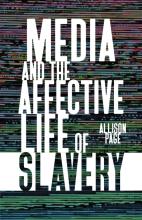
Allison Page's Media and the Affective Life of Slavery embarks on a less-discussed aspect of the legacy of slavery—that of how its narrative can be used to regulate the emotions, including guilt, of its consumers and thus to implicitly suggest that its legacy is no longer an issue in the present day. This text squarely addresses scholars in the domains of communication, digital media, and media and cultural studies and production. Per Page's introduction (9), her work acknowledges the Black feminist lens through which chattel slavery has been examined by Black literary scholars. However, Page's book also touches other disciplines, including psychology, cognitive studies, and critical information and media literacy.
Although not explicitly an interdisciplinary text, this work is clear in its multifaceted objectives and beautifully meets them. Page describes her work as one that "explores races and racialized subjectivity" by examining "how media and the visual … provide templates for racialized subjectivity through producing and disciplining emotion" (3). Media also addresses the shifts to antiracism discussions after World War II and the civil rights movement in terms of racial formation in the United States.
Chapter 1 focuses on four 1960s documentaries about Black life in America, which, Page writes, contributed to the "pathologization of Black anger, which in turn produced white innocence and fear" (14). The reader unquestionably sees this same pathology, innocence, and fear in today's society and media.
Chapter 2 explores the reader's emotional responses to racism, specifically via the 1970s television miniseries Roots, based on the Alex Haley classic. Page posits that non-Black television viewers have been conditioned to "feel admiration for Black struggle and sympathy for African Americans," while Black viewers felt pride as a result of Kunta Kinte's transformation (49).
Chapter 3 examines two PBS interactive educational games, Flight to Freedom and Mission U.S. Their interactivity and, in the case of Mission U.S., the inhabitation of characters presumably allow players to try on the experiences of others and develop empathy. Instead, they may allow players to downplay and compartmentalize the horrors of slavery. In this chapter Page signals the shift to "neoliberal multiculturalism," suggesting that these games engender empathy for slaves who "had agency" and teach a version of civics that rehabilitates Blackness and says that everyone is human (79).
Chapter 4 presents the US State Department's website, Slavery Footprint, and its accompanying digital app. Not only does the website promote the idea that anything digital is neutral and therefore unproblematic, but the digital is positioned as "separate from race [End Page 205] and capitalism" and the solution to racial strife (19). The website presents "interactivity as a means toward racial understanding" and confers a "transactional and colorblind notion of difference" (17). Overall, Page says that this version of racial understanding is an "entanglement of race, emotion, algorithmic governance, and digital media in the shift towards an emergent formation presuming the neutrality of data" (17).
The conclusion of Media and the Affective Life of Slavery is the best section of the book, as it applies the threads established in the case study chapters to a current piece of art, Kara Walker's 2014 giant sugar sphinx entitled A Subtlety. The bigger-than-life sculpture was a thirty-five-foot-high, seventy-five-foot-long sphinx with mammy features created of bleached white sugar and placed in the Domino Sugar Factory in Williamsburg, New York. The sculpture paid homage to the people who labored in the sugarcane fields and subsequently cooked with sugar in segregated and oppressive kitchens. Analyzing a documentary about the sphinx and its audience of visitors and viewers, Page points out all the elements introduced in chapters 1 through 4. In response to viewers' behaviors, including selfies, tears, and children attempting to eat the sugar, Page points out that there is no one right way to react to the artwork and to the violent legacy it commemorates because of their unruliness, messiness, and complication.
Page's book is rightfully concerned with hegemonic media, which romanticizes the antebellum period, as well as with such events as tours and weddings hosted at plantations. Such media and experiences also whitewash and downplay issues of race, which subsequently influences how people interact, or do not interact, with topics such as antiracism, the murder of George Floyd, policy brutality toward Black and Brown bodies, and so on. These media "are also biopolitical, capable of discipline and management at the level of population through both the affordances of form and their broader uptake in concert with policy, political discourse, and institutions" (7).
The absence of other current work on this topic makes this book unique; it extends the aforementioned work on slavery in the literary realm. Page's treatise also extends the work of media, communication, and television scholars, and it contributes to the disciplines of critical information and media literacy. Teachers and scholars in a wide variety of classrooms should consider Media to introduce a more nuanced understanding of race in America.
Page presents a compelling, albeit initially challenging, text. For scholars outside of Page's domain, it may take some time to understand her interdisciplinary topic, as Media is not framed (or intended) as an interdisciplinary work. However, once I could see my own discipline (information and media literacy) in her work, everything clicked, and the case studies and history presented took on an entirely new meaning. The core of this book is painful and profound but essential to an understanding of the multidisciplinary legacy and impact of slavery in the culture of the United States. [End Page 206]
—Nicole A. Cooke, University of South Carolina

